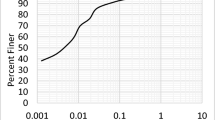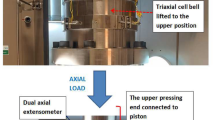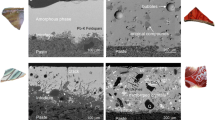Abstract
The sawing of granite blocks using multi-blade gangsaws and an abrasive mixture is one of the most complex operations in the rock transformation industry. The surface quality of the finished slabs is the major determinant of the volume of material to be removed in subsequent polishing operations, thus influencing the final cost of the product. To determine this quality, a portable piece of equipment which records direct measurements of the roughness of the slab surface was developed. The measurements were carried out on two types of granite slabs of high commercial value. These granites showed mineralogical similarities, but great differences in cutting speed and the cost of the industrial process. The paper discusses the results in relation to Knoop hardness, Amsler wear, deep abrasion and petrography and concludes that the texture of the rock has the most important influence on the cost of production of polished slabs.
Résumé
Le sciage de blocs de granite à l’aide de scies multi-lames et de produits abrasifs est l’une des opérations les plus complexes dans l’industrie de transformation des pierres dimensionnelles. La qualité de surface des plaques réalisées contrôle le volume de matériau à enlever dans les opérations de polissage, influençant ainsi le coût du produit final. Afin de déterminer cette qualité, un équipement portatif permettant de mesurer la rugosité des surfaces de ces plaques a été mis au point. Les mesures ont été réalisées sur deux types de plaques de granite de forte valeur commerciale. Ces granites présentaient des caractéristiques minéralogiques semblables, mais de grandes différences dans les vitesses de découpe et le coût du procédé industriel. L’article présente les résultats obtenus relatifs à la pétrographie et aux tests de dureté de Knoop, de résistance au polissage de Amsler, d’abrasivité profonde. Il conclut que la texture de la roche a la plus forte influence sur le coût de production des plaques polies.






Similar content being viewed by others
References
Associação Brasileira de Normas Técnicas–ABNT (1992) NBR 12042. Materiais inorgânicos—determinação do desgaste por abrasão
Blasi P, Comazzi G, Frisa Morandini A, Marini P (1995) Prenormative research concerning the measurement of polish of stone elements. Lisboa: 1° Congresso Internacional da Pedra Natural, p18–22
Citran G (2000) La segagione de graniti. Giorgio Zusi Editore, Verona, p 127
Citran G (2002) Cutting performance with granites using metal shot and multi-blade gangsaws. Litos 59:1–7
Comazzi G, Frisa Morandini A, Tassone P (1995) Prenormative research on abrasive wear test methods for stone elements. Lisboa. 1 Congresso Internacional da Pedra Natural 32–36
European Comitee for Standardization – CEN (2000) EN 12407. Natural stone test methods—petrograhic examination
European Comitee for Standardization–CEN (2004) EN 14157. Natural stone test methods—abrasion resistance
Fachada MCBS (1999) Influência dos parâmetros geotécnicos e operacionais na serragem industrial de granitos. Lisboa. Dissertação de Mestrado. Instituto Superior Técnico. Universidade Técnica de Lisboa, p 84
Fornasero D, Frisa Morandini A, Mancini R (1988) Petrografia e durezza di graniti come termini di una scala di segabilità al telaio. Marmomacchine 83:97–107
Frisa Morandini A, Oggeri C (1992) Determinazione della rugosità delle superfici lavorate e della porosità in pietre ornamentali. Saint Vicent: Eurocave’92—Atti 1a Conferenza Europea sulle Cave, p 301–304
González-Mesones FL (2005) La utilización de la piedra natural em la arquitectura en el marco de la nueva normativa europea.First International Congress on Dimension Stones (CD-ROM), Guarapari
Mancini R, Frisa Morandini A (1982) Applications of microhardness tests to the technical evaluation of dimension stones. Fourth Congress International Association of Engineering Geology, New Delhi, p 321–331
Montani C (2005) International stone market. Brazil´s role and how Italian technology has contributed to its rapid development. First International Congress on Dimension Stones (CD-ROM), Guarapari
Moraes MC, Rodrigues EP (1978) Exemplo de aplicação de coloração seletiva de feldspatos potássicos e cálcicos, como técnica auxiliar no estudo de rochas. Cerâmica 24(97):32–35
Mummery L (1992) Surface texture analysis. Hommelwerke, Muhlhausen, p 105
Quitete EB (2002) Dureza knoop em rochas para revestimento: metodologia e correlação com desgaste abrasivo. Dissertação de Mestrado. Escola Politécnica da Universidade de São Paulo, São Paulo
Ribeiro RP, Paraguassú AB, Silveira LL, Rodrigues JE, Moredo HC (2005) Roughness evaluation of granite slabs sawed in multiblade gangsaws. First International Congress on Dimension Stones (CD-ROM), Guarapari
Rossi G, Trois P, Andrissi GS (1997) La segabilità dei graniti e l´ambiente físico-chimico. Marmomacchine 133:180–192
Spínola, SVPAC (1998) Influência da qualidade da serragem de granitos no consumo energético do desbaste. Dissertação de Mestrado. Instituto Superior Técnico, Lisboa
Sousa AAP, Rodrigues R (2002) Consumo dos principais insumos no desdobramento de granitos do nordeste, de diferentes graus de dureza. Second Simpósio de rochas Ornamentais do Nordeste, Brasil, pp 171–178
Acknowledgements
The authors would like to thank the Fundação de Amparo à Pesquisa do Estado de São Paulo (FAPESP) for their financial assistance; Centro Tecnológico do Mármore e Granito (CETEMAG), Instituto de Pesquisa Tecnológica do Estado de São Paulo (IPT), Fundação Parque de Alta Tecnologia de São Carlos (PARQTEC) and Granitos Moredo S.A. for their help and support during the experimental phases; Drs. Ely Borges Frazão and Antonio Carlos Artur for constructive criticism and Dr. Bruce Ekane Ewang for reading and revising the script.
Author information
Authors and Affiliations
Corresponding author
Rights and permissions
About this article
Cite this article
Ribeiro, R.P., Paraguassú, A.B. & Rodrigues, J.E. Sawing of blocks of siliceous dimension stone: influence of texture and mineralogy. Bull Eng Geol Environ 66, 101–107 (2007). https://doi.org/10.1007/s10064-006-0049-y
Received:
Accepted:
Published:
Issue Date:
DOI: https://doi.org/10.1007/s10064-006-0049-y




